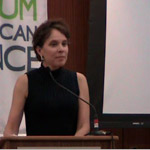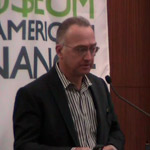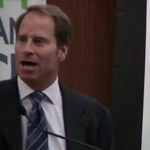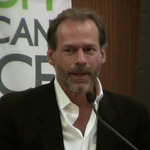The Skyscraper Museum is devoted to the study of high-rise building, past, present, and future. The Museum explores tall buildings as objects of design, products of technology, sites of construction, investments in real estate, and places of work and residence. This site will look better in a browser that supports web standards, but it is accessible to any browser or Internet device.
The Rise of Wall Street Lecture Series
In conjunction with its 2010 exhibition, The Rise of Wall Street, The Skyscraper Museum presented a series of lectures extending public access to the exhibition's themes. These lectures gathered leading historians, architects, public servants, developers, and community organizers to discuss both the past and the future vision of America's most iconic street.
Exhibition Overview
THE RISE OF WALL STREET charts the architectural evolution of one of the world's most famous locales. "Wall Street" is a broad metaphor for the American center for global finance and a real place with an inordinately rich history layered into every lot of its nearly half-mile length, stretching from Trinity Church on Broadway to the East River.
From colonial times, when the first bastions were erected to mark the edge of town, Wall Street has been continuously transformed, both in function --from commercial and residential to financial --as well as in scale. Row houses were replaced by low-rise banks, then massive high-rise office buildings. The skyscrapers that line Wall Street today represent the climax species of an intense urban process that the exhibit documents with graphics of successive buildings on a given site since 1850. These "Vertical Wall Street" images dramatically illustrate the cycles of growth that shaped the financial district over time, charting both the evolution from small to tall and the growing girth of buildings enabled by new technologies and slow, but savvy site assembly.
The Rise of Wall Street Lectures and Programs
Whither Wall Street
- October 13 2010 | WHITHER WALL STREET
- Museum of American Finance
- 48 Wall Street
- New York, NY 10005
A program organized by The Skyscraper Museum in partnership with the Museum of American Finance. Addressing the changing fortunes of Wall Street--not the forecast of financial markets, but the architectural assets and liabilities of the physical place--our panel of experts discusses the recent history and possible futures of America's most famous street. Focusing on the widespread conversion of office buildings to residential, hotel, new retail uses, expanded tourism, and the demands on the design of the public realm that need to serve the conflicting needs of both access and security of a post-9/11 world.
- Evening Overview and Bios
- Introduction and moderator: Carol Willis, Director, The Skyscraper Museum
- Elizabeth H. Berger, President, Downtown Alliance
- Rob Rogers, Principal, Rogers Marvel Architects; streetscape designer of Wall Street for the NYC Department of City Planning
- Kent Swig, President of Swig Equities, LLC; owner of a portfolio of properties on Wall Street and in the Financial District
- Alexandros Washburn, Chief Urban Designer, NYC Department of City Planning
- Panel Discussion
KATHRYN HOLLIDAY
Ralph Walker and the Making of 1 Wall Street
October 25 2010
Click here to watch our video of the lecture
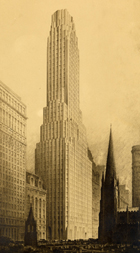 The great Art Deco tower of 1 Wall Street culminates architect Ralph Walker's 1920s skyscraper designs. More expensive and elaborate than his firm's many previous telephone and telegraph buildings, 1 Wall Street epitomized Walker's concept of "humanism," a modern approach to the integration of hand-craft and machine work, expressed inside and out in�the building's rippling curtain walls and dramatically draped interior spaces.
The great Art Deco tower of 1 Wall Street culminates architect Ralph Walker's 1920s skyscraper designs. More expensive and elaborate than his firm's many previous telephone and telegraph buildings, 1 Wall Street epitomized Walker's concept of "humanism," a modern approach to the integration of hand-craft and machine work, expressed inside and out in�the building's rippling curtain walls and dramatically draped interior spaces.
Kate Holliday is an architectural historian and Assistant Professor at the School of Architecture at the�University of Texas at Arlington. Her�research focuses on American architecture and theory, particularly interactions with Europe. Her book Leopold Eidlitz: Architecture and Idealism in the Gilded Age (W. W. Norton, 2008) won the 2008 Book of the Year Award from the southeast chapter of the Society of Architectural Historians.
DANIEL ABRAMSON
Skyscraper Rivals Revisited:
Wall Street in the Roaring Twenties
Click here to watch the video of the Daniel Abramson Booktalk: Skyscraper Rivals Revisited
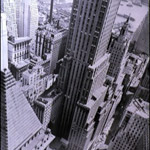 Architectural historian Daniel Abramson focused his 2001 book Skyscraper Rivals: The AIG Building and the Architecture of Wall Street on the spectacular generation of Art Deco towers that mushroomed throughout the financial district in the 1920s. His talk revisited the rich history his original research uncovered and reflected on the relevance of recent developments on the street.
Architectural historian Daniel Abramson focused his 2001 book Skyscraper Rivals: The AIG Building and the Architecture of Wall Street on the spectacular generation of Art Deco towers that mushroomed throughout the financial district in the 1920s. His talk revisited the rich history his original research uncovered and reflected on the relevance of recent developments on the street.




